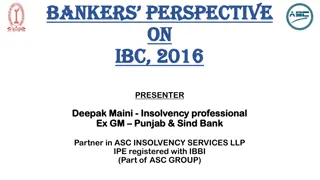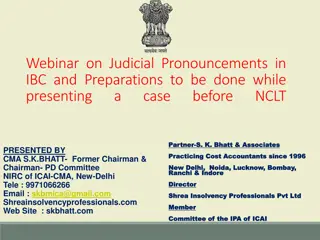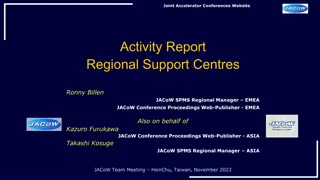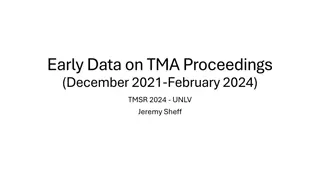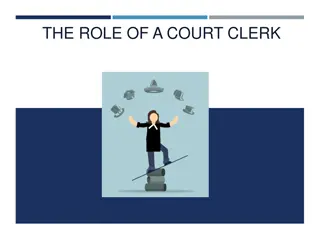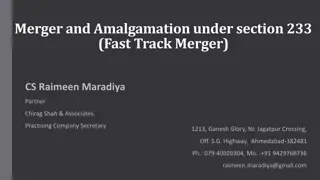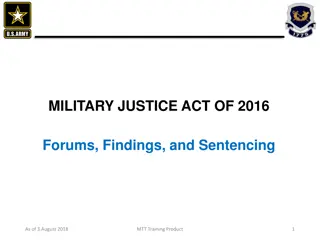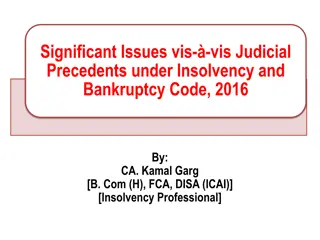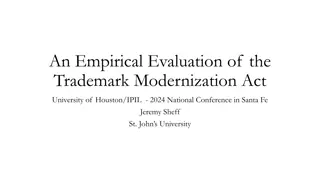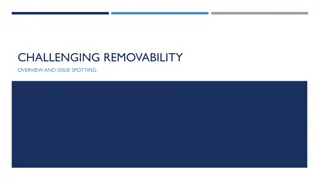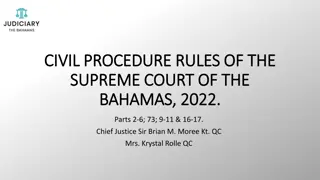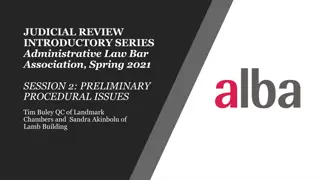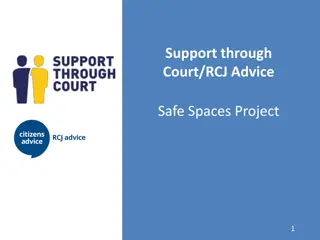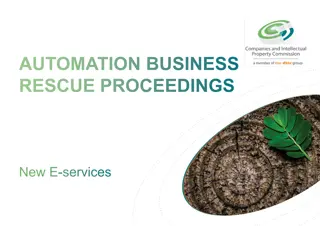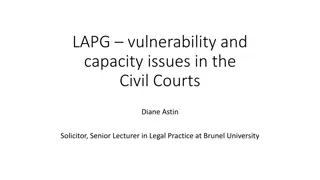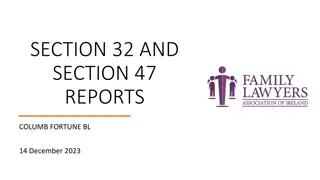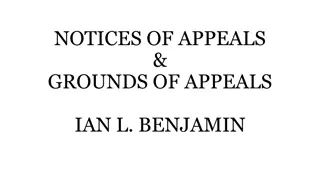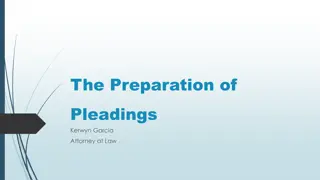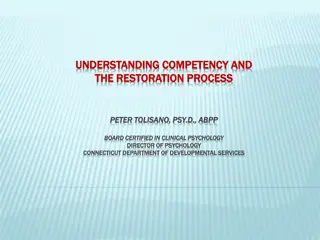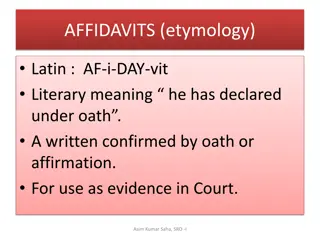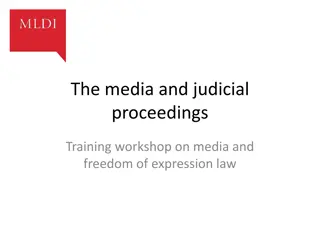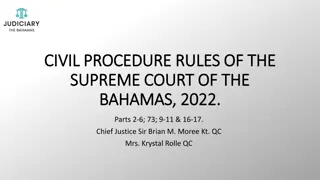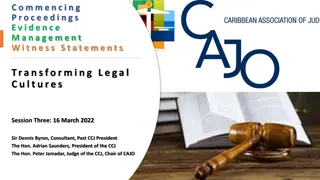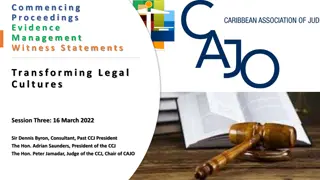Impact of COVID-19 on NCLT Proceedings - Overview and Analysis
Explore the impact of COVID-19 on NCLT proceedings, covering the scope under Companies Act 2013, IBC 2016, present position due to the pandemic, and future outlook. Learn about the National Company Law Tribunal, its functions, and jurisdiction, along with the advantages it offers. Discover the specialized branches of NCLT and its significance in corporate governance.
Download Presentation

Please find below an Image/Link to download the presentation.
The content on the website is provided AS IS for your information and personal use only. It may not be sold, licensed, or shared on other websites without obtaining consent from the author. Download presentation by click this link. If you encounter any issues during the download, it is possible that the publisher has removed the file from their server.
E N D
Presentation Transcript
IMPACT OF COVID 19 ON NCLT PROCEEDINGS CS GS SARIN B. Com., LLB ,MFC, IP,FCS Chairman NIRC-ICSI SWIFT INSOLVENCY PROFESSIONAL LLP SCO 186-187 3rd Floor, Sector 17-C, Chandigarh 2
POINTS OF DISCUSSION FR TODAYS WEBINAR Scope under Companies Act, 2013. Scope under IBC 2016. NCLT Proceedings since inception. Present Position of the proceedings at NCLT due outburst of COVID 19. Future of NCLT proceedings. 3
National Company Law Tribunal The National Company Law Tribunal was setup by the Central Government in 2016 under Section 408 of the Companies Act, 2013. The National Company Law Tribunal has been setup as a quasi-judicial body to govern the companies registered in India and is a successor to the Company Law Board. In today s presentation, we look at the National Company Law Tribunal, its functions and powers in detail. 4
Scope of National Company Law Tribunal The National Company Law Tribunal (NCLT) consolidates the corporate jurisdiction of the Company Law Board, Board for Industrial and Financial Reconstruction (BIFR), The Appellate Authority for Industrial and Financial Reconstruction (AAIFR) and the powers relating to Winding up or restructuring and other provisions, vested in High Courts. Hence, the National Company Law Tribunal will consolidate all powers to govern the companies registered in India. With the establishment of the NCLT and NCLAT, the Company Law Board under the Companies Act, 1956 has now beendissolved. 5
Advantages for National Company Law Tribunal NCLT is a specialized court only for Corporates, i.e., companies registered in India. NCLT will reduce the multiplicity of litigation before different forums and courts. NCLT has multiple branches and is able to provide justice at a close range. NCLT consists of both judicial and technical members while deciding on matters. The time taken to windup a company is reduced. Speedy disposal of cases will help reduce the number of cases. NCLT & NCLAT have exclusive jurisdiction. 6
NCLT BENCHES S, NO NAME OF THE BENCHES 1. NCLT, Principal Bench and NCLT, New Delhi Bench 2. NCLT, Ahmedabad Bench 3. NCLT, Allahabad Bench. ... 4. NCLT, Bengaluru Bench 5. NCLT, Chandigarh Bench 6. NCLT, Chennai Bench 7. NCLT Guwahati Bench 8. NCLT Hyderabad Bench 9. NCLT Kolkata Bench 10. NCLT Mumbai Bench 11. NCLT Jaipur Bench. 12. NCLT Cuttak Bench 7
NCLT BENCHES S, NO NAME OF THE BENCHES 13. NCLT, Kochi Bench 14. 15. NCLT Amravati Bench, Hyderabad NCLT Indore Bench, Ahmedabad 8
TERRITORIAL JURISDICTION OF THE NCLT S, NO Name of the Bench Address of the Bench 1 NCLT, Principal Bench and NCLT, New Delhi Bench NCLT, New Delhi Bench. Block No. 3, Ground Floor, 6th,7th & 8th Floor, CGO Complex, Lodhi Road, New Delhi-110003 Jurisdiction: Union Territory of Delhi. 2 NCLT, Ahmedabad Bench Anand House, Ground Floor, 1st & 2nd Floor, SG Highway, Thaltej, Ahmedabad-380054 Jurisdiction: State of Gujarat, State of Madhya Pradesh, Union Territory of Dadra and Nagar Haveli, Union Territory of Daman and Diu 3 NCLT, Allahabad Bench Address: 9th Floor, Sangam Place, Civil Lines Allahabad 211001 Jurisdiction: State of Uttar Pradesh, State of Uttrakhand 9
TERRITORIAL JURISDICTION OF THE NCLT S, NO Name of the Bench Address of the Bench 4. NCLT, Bengaluru Bench Address: Corporate Bhawan, 12th Floor, Raheja Towers, M.G., Road, Benguluru 160019 Jurisdiction: State of Karnataka 5. NCLT, Chandigarh Bench Address: Ground Floor, Corporate Bhawan, Sector-27 B, Madhya Marg, Chandigarh-160019 Jurisdiction: State of Himachal Pradesh, State of Jammu and Kashmir, State of Punjab, Union Territory of Chandigarh, Haryana. 6. NCLT, Chennai Bench Address: Corporate Bhawan (UTI Building), 3rd Floor, No. 29 Rajaji Salai, Chennai-600001 Jurisdiction: State of Kerala, State of Tamil Nadu, Union Territory of Lakshadweep, Union Territory of Puducherry 10
TERRITORIAL JURISDICTION OF THE NCLT S, NO Name of the Bench Address of the Bench NCLT Guahati Bench Address: 4th Floor, Prithvi Planet Behind Hanuman Mandir, G.S. Road, Guahati-781007 Jurisdiction: State of Arunchal Pradesh, State of Assam, State of Manipur, State of Mizoram, State of Meghalaya, State of Nagaland, State of Sikkim, State of Tripura 7. NCLT Hyderabad Bench Address: Corporate Bhawan, Bandlaguda Tattiannaram Village, Hayatnagar Mandal, Rangareddy District, Hyderabad-500068 Jurisdiction: State of Andhra Pradesh, State of Telangana 8. NCLT Kolkata Bench Address: 5, Esplanade Row (West), Town Hall Ground and 1st Floor Kolkata-700001 Jurisdiction: State of Bihar, State of Jharkhand, State of Odisha, State of West Bengal, Union Territory of Andaman and Nicobar Island 9. 11
TERRITORIAL JURISDICTION OF THE NCLT S, NO Name of the Bench Address of the Bench 10. NCLT Mumbai Bench Address: 6th Floor, Fountain Telecom Building No.1, Near Central Telegraph, M.G. Road, Mumbai 400001 Jurisdiction: State of Chhattisgarh, State of Maharashtra, State of Goa 11. NCLT Jaipur Bench State of Rajasthan 12. NCLT Cuttak Bench State of Chhattisgarh. State of Odisha. 13. NCLT Kochi Bench State of Kerala Union Territory of Laksha 12
TERRITORIAL JURISDICTION OF THE NCLT S, NO Name of the Bench Address of the Bench 14. NCLT, Amaravati Bench State of Andhra Pradesh 15. NCLT, Indore Bench. State of Madhya Pradesh 13
JURISDICTION OF NCLT UNDER COMPANIES ACT,2013 S,no Section Description 1. Sec. 2 (41) * Application for change in Financial year. 2. Sub-section (7) of section 7 [except clause (c) and (d)] Legal action for false or incorrect information at the time of Incorporation . 3. Section 14 * Conversion of Public to Private Limited. 4. Section 55 Section 58 Section 59 Rollover of existing redeemable preference shares . Appeal against Refusal of Registration of Shares. Appeal for Rectification of Register of Member 14
JURISDICTION OF NCLT UNDER COMPANIES ACT,2013 S,no Section Description 5. Section 61 Changes in voting rights by Consolidation or sub-division of share Capital . 6. Section 62 Appeal by the company to Tribunal where Govt. Direct the company to convert the loan/ debentures into equity and company is not agreeing to the terms of the govt. 7. Section 71 ,73 ,74 &75 Action by Debenture trustee once the secured Assets becomes insufficient. Application by Deposition for repayment of Deposit or interest. Action against Company by defrauding Depositors by non-payment. 15
JURISDICTION OF NCLT UNDER COMPANIES ACT,2013 S,no Section Description 8. Section 97 Power to call for AGM in case of failure by the Company 9. Section 98 Power to call for meetings other than AGM 10. Section 99 Punishment for failure to comply with Tribunal Direction regarding Meetings 11. Section 119 Order for inspection in case of failure by the Company 12. Section 130 Re-opening of Accounts by Authorities 13. Section 131 Voluntary revision of financial statements 14. Section 140 Removal or change of Auditor before due Date and Suo Moto action by Tribunal for removal 15. Section 169 Removal of Directors representation and relaxation of provisions in certain cases 16
JURISDICTION OF NCLT UNDER COMPANIES ACT,2013 S,no Section Description 16. Section 213 Investigation into the affairs of the Company 17. Section 216 Appointment of Inspectors 18. Section 218 Protection of employees during investigation 19. Section 221 Freezing of assets of Company on inquiry and investigation 20. Section 222 Imposition of restrictions upon securities 21. Section 224 Action by Tribunal on report of inspector, being furnished by the Central Government to the Tribunal, in case the company or any KMP has take any undue advantage. 22. Section 230-232 Merger & Amalgamation 23. Section 241 to 245 Action against Prevention and Oppression and Mismanagement 24. Section 252-254 Restoration of the Name of the Company. 17
JURISDICTION OF NCLT UNDER COMPANIES ACT,2013 S,no Section Description 25. Section 399 Order for production of documents by Registrar 26. Section 415-433 Tribunal and its Chairman, Members etc and provisions relating thereto. 27. Section 425 Petition for initiating contempt. 28. Section 434 Transfer of pending proceedings & 434 Appeal against Company Law Board Order 29. Section 441 ** Compounding of offences 30. Section 466 Dissolution of CLB and consequential provisions 18
Dress Code of Members Guidelines for Professional Dress of Company Secretaries With a view to enhance the visibility and brand building of the profession and ensuring uniformity, the Council of the Institute of Company Secretaries of India at its 148th Meeting held on 27th & 28th March, 2004 at New Delhi, has prescribed the following guidelines for professional dress for members while appearing before judicial / quasi-judicial bodies and tribunals: 1. The professional dress for male members will be Navy Blue suit and white shirt with a tie (preferably of the ICSI) or navy blue buttoned-up coat over a pant or a navy blue safari suit. 2. The professional dress for female members will be sari or any other dress of a sober colour with a Navy Blue jacket. 3. Members in employment may wear the dress/uniform as specified by the employer for all employees or if allowed the aforesaid professional dress. 4. Practising Company Secretaries appearing before any tribunal or quasi-judicial body should adhere to dress code if any prescribed for appearing before such tribunal or quasi-judicial body or if allowed the aforesaid professional dress. 19
TIPS FOR THE APPEARANCE IN THE NCLT FOLLOWING ARE THE BASIC STEPS TO BE FOLLOWED :- 1. Be on time. 2. Properly dressed with prescribed dress code. 3. Sit in the court room and concentrate on your case. 4. Don t roam around in the collidoor, if free or idle sit in bar room. 5. You should be aware off, where to stand as petitioner or responded. 6. Keep cause list of the day with yourself. 7. Prepare short notes for your case. 20
TIPS FOR THE APPEARANCE IN THE NCLT 8. Be honest to the court. 9. Don't speak lie and irrelevant in the court. If you are not sure, ask for adjournment. 10. Watch proceeding as much you can , it will help you to prepare your cases. 11. Keep eyes and ear open and control on the tongue. 12. Prepare your case well and revise your case on the day of hearing. 13. Don't speak in between ,if opposite council is speaking. 14. Address the bench respectfully. 15. Keep your mobiles silent and avoid using the same in court room. Don't gossip in the court room. 21
23 Why was it needed? Erstwhile Insolvency Legislations Contents Modern but ineffective existing Insolvency cum recovery Legislations Insolvency & Bankruptcy Code, 2016 ( IBC ) Key Features Insolvency Resolution for Corporate Debtors Insolvency Resolution for Non-Corporate Debtors Filing of Application under IBC & contentious issues &Recent Amendments
24 Why was it needed? Indian Banks have become increasingly vulnerable to poor recovery on loans made to corporates; Gross NPAs of the banking system have risen from 2.4 percent in 2008 to 4.8 percent in 2015; Restructured advances (i.e. loans whose terms have been revised and which have a higher probability of becoming NPA in future) have increased from 1.2 percent in 2008 to 6.8 percent in 2015; Nearly 60,000 bankruptcy cases pending in Courts; Recovery of Debts too low vis- -vis other countries; We do not punish the wrong-doer unless he is small and weak No one wants to go after the rich and well-connected wrong-doer, which means they get away with even more. - Mr. Raghuram Rajan, Ex-Governor Reserve Bank of India
25 Erstwhile Insolvency & Bankruptcy Legislations- Now Repealed The Presidency Towns Insolvency Act, 1909 Covers the insolvency of individuals and of partnerships associations of individuals in the three erstwhile Presidency towns of Chennai, Kolkata and Mumbai. and Covers the insolvency law for individuals in areas other than the Presidency towns, insolvency of individuals, including individuals as proprietors. The Provincial Insolvency Act, 1920 deals with
Journey of Ease of Doing Business in India 26
Indias ease of doing business ranking over the last six years Rank S, NO 1. 2. 3. 4. 5. 6. YEAR 2019 2018 2017 2016 2015 2014 RATING 63 77 100 130 130 142 27
29 Modern but ineffective Insolvency cum recovery Legislations Multiple laws- Recovery of Debts Due to Banks and Financial Institutions Act, 1993 Securitisation and Reconstruction of Financial Assets and Enforcement of Security Interest Act, 2002 Sick Industrial Companies (Special Provisions) Act, 1985 Winding up under the old Companies Act, 1956 Lack of holistic remedy System of Official Liquidator has not been successful Banks can turn to separate Debt Recovery Tribunal, partly staffed by Bank officials and overseen by the Ministry of Finance and both are overstretched with piles of files lying under pendency Approach of "interim fixes designed to solve the problem at hand in the present reform process
Single umbrella legislation governing all Insolvency and Bankruptcy proceedings in India 30
31 Legislative road to the Birth of IBC Committee Report was in two parts: 1. Rationale and Design/ Recommendations 2. A comprehensive draft Insolvency and Bankruptcy Bill covering all entries 28th May, 2016 President s assent to Insolvency and Bankruptcy Code (hereinafter referred to as IBC or the Code ) 5th May, 2016 & 11th May, 2016 Insolvency and Bankruptcy Bill passed by Lok Sabha and Rajya Sabha respectively 4th Nov, 2015 Final Report by Bankruptcy Law Reforms Committee 22nd Aug, 2014 Bankruptcy Law Reforms Committee formed
32 Key Features Applicable to both corporate and non-corporate persons. Allow creditors, whether secured or unsecured; financial or operational; domestic or international, to initiate a resolution process thereby aiming for an early detection of the fraud. Establishes time-bound moratorium on acceleration and enforcement of debts against the debt defaulter. The resolution professionals shall replace the existing management during insolvency proceedings. Provides for time-bound viability assessment mechanisms, liquidation processes and distribution waterfalls. Provides for penalties on promoters for asset diversion leading up to liquidation. An inability to pay debt will no more be a ground for winding up under the Companies Act. Voluntary Liquidation shall be subject to provisions of the Code.
Is meaning of Insolvency and Bankruptcy same? The meaning of Insolvency and Bankruptcy is not same Insolvency means the situation where an entity (debtor) cannot raise enough cash to meet its obligations or to pay debts as they become due for payment. Symptom of Insolvency may include: poor cash management, increase in cash expenses, or decrease in cash flow etc. Bankruptcy occurs when a court has determined insolvency, and has given legal orders for resolution. On declaring the person as bankrupt, the court is responsible to liquidate the personal property of the insolvent and distribute the property amongst the creditors of the insolvent debtors. Thus Insolvency is a situation where a debtor is unable to meet his obligations and the Bankruptcy is a legal process by which an insolvent debtor seeks relief. 33
34 IBC is a boon to the ailing insolvency system Low time to resolution Low loss in recovery Higher levels of debt-financing across a wide variety of debt instruments
35 Framework of the Code Regulator Adjudicator Insolvency and Bankruptcy Board of India (IBBI) National Company Law Tribunal Debt Recovery Tribunal 1. Insolvency Professional Agencies Non- Corporate Entities Corporate Entities 2. Insolvency Professionals Individuals/ Partnership Firms Companies/ LLPs 3. Information Utilities
36 What to do to revive the Corporate Debtor? Insolvency Resolution Process For Non-Corporate Entity (Individual/ Partnership Firm) For Corporate Entity Corporate Insolvency Resolution Process (CIRP) Insolvency Resolution Process (IRP) The Code defines a default maximum IRP period for corporate and non-corporate entities within which to conclude the negotiations to find a solution to the insolvency of the entity.
Report card of the IBC Total CIRPs since inception: 3,774 Total number of closed CIRPs: 1,604 (43 percent of total cases since inception) Number of ongoing CIRPs: 2,170 (57 percent of total cases since inception) Cases that found resolution under IBC: 221 (14 percent of closed cases) Cases that ended in liquidation: 914 (57 percent of closed cases) Cases that were withdrawn under Section 12A: 157 Cases closed on appeal/settled: 312 37
Report card of the IBC As many as 19771 cases have been filed since the implementation of the Insolvency and Bankruptcy Code (IBC) and setting up of the National Company Law Tribunal (NCLT). Around 4,500 cases have been settled before resolution to a settlement amount of almost 2 lakh crore. 2173 cases have been admitted. 6,000 cases are waiting in queue. 38
STATUS OF THE 12 BIG CASES Four of the 12 large cases of bank loan defaults referred to the National Company Law Tribunal (NCLT) for resolution under the Insolvency and Bankruptcy Code (IBC), which have been resolved so far, have led to a recovery of 52 per cent of the claims made by financial creditors. The banks have been able to recover Rs 48,117 crore against claims of Rs 92,817 crore, the recently released News Letter by the regulator, Insolvency and Bankruptcy Board of India, showed. These four cases include that of Electrosteel Steels, which was bought by Vedanta for Rs 5,320 crore against claims of Rs 13,175. The recovery rate in case of Electrosteel was 40.38 per cent. The second one was that of Bhushan Steel, which was acquired by Bamnipal Steel, a subsidiary of Tata Steel, for Rs 35,571 crore against bankers claim of Rs 56,022 crore, logging a recovery rate of an impressive 63.5 per cent. 40
STATUS OF THE 12 BIG CASES Monnet Ispat & Energy was acquired by a Consortium of JSW and AION Investments for Rs 2,892 crore against bankers' claim of Rs 11,015 crore, a recovery rate just over 26 per cent. The fourth case to be resolved was Amtek Auto, which was bought over by Liberty House for Rs 4,334 core, which is 34 per cent of the bankers' claim of Rs 12,605 crore. The 12 large cases together accounted for an outstanding debt of Rs 3.45 lakh crore as against liquidation value of Rs 73,220.23 crore. 41
Three Years of IBC It s three years since Parliament passed the Insolvency and Bankruptcy Code (IBC) and about 30 months since the first case was filed under the new law. It s the landmark reform of the past five years and has boosted India s rankings in the World Bank s ease of doing business. But the track record in bad loans resolution has been less than satisfactory owing to a variety of factors. Cases are mired in litigation, timelines haven t been adhered to, the law itself has been amended a couple of times, and the bankruptcy infrastructure hasn t been ramped up as needed for quicker and effective resolution. Still, the fact remains that IBC was a much-needed, long- awaited reform which, despite warts and all, is an improvement over the previous tools available to creditors to recover their money from defaulters. 42
Shifting the Balance of Power The IBC s promise can be summed up thus: When a defaulting company is taken to bankruptcy court, its management passes on to a resolution professional. If resolution doesn t take place within 180 days (plus a 90-day grace period), the defaulter is sent to liquidation. What it does is shift the balance of power from the debtors to creditors. Promoters who held banks to ransom by refusing to pay up their dues could no longer do so simply because they stand to lose their company. The IBC ensured that promoters no longer have any rights over their firms after mismanagement. This naturally helps install better credit discipline and helps release capital for banks. 43
IBC TOOL FOR THE FINANCIAL DISCIPLINE One of the biggest successes of the IBC is the behavioural change it has induced in corporate debtors. The Supreme Court judgement earlier this year which upheld the constitutional validity of the bankruptcy law adds teeth to the IBC. Moreover, it s not only banks which can trigger the IBC. Employees, vendors, distributors and other operational creditors can take a firm to court for unpaid dues. When creditor rights are strengthened, it helps deepen the corporate bond market as well. For entrepreneurs, the IBC offers a easy and quick route for winding up their business. 44
45 Who Can Initiate CIRP against a Corporate Debtor ( CD ) A Financial Creditor An Operational Creditor Corporate Debtor ( Defaulter ) itself The Trigger Point of initiation of CIRP is occurrence of default by CD where the minimum amount of the default is Rupees one lakh (Rs.1,00,000)
Nationwide lock down on account of Covid-19 pandemic with effect from 25 March 2020. The Government of India (GOI) announced a nationwide lock down on account of Covid-19 pandemic with effect from 25 March 2020. This has severely disrupted regular business activities across all sectors of the economy in the country. The quarterly newsletter issued by the Insolvency and Bankruptcy Board of India (IBBI) for the quarter October December 2019, states that as on 31 December 2019, there are approximately 1,961 entities which were undergoing a corporate insolvency resolution process (CIRP) under the Insolvency and Bankruptcy Code, 2016 (Code). 46
It is in respect of the corporate debtors presently undergoing CIRP under the Code, that the lockdown has made it near impossible for all the stakeholders involved in the process, to participate effectively and perform their respective functions within the timelines as stipulated under the Code. 47
Implication of the present lockdown in the wake of Covid-19 outbreak on the timelines of CIRP What is the implication of the present lockdown in the wake of Covid-19 outbreak on the timelines prescribed in respect of CIRP under the Code? The IBBI has vide notification dated March 29, 2020 amended the CIRP Regulations by insertion of regulation 40C. Pursuant to regulation 40C, the lock down period shall be excluded for the purpose of computation of the time frame for completion of the various activities forming a part of the CIRP. Regulation 40A provides a comprehensive list of the activities required to be undertaken to complete the CIRP along with timelines. 48
Implication of the lockdown on the time limit prescribed for completion of CIRP under Section 12 of the Code What is the implication of the lockdown on the time limit prescribed for completion of CIRP under Section 12 of the Code? Section 12 of the Code provides that CIRP is to be completed within 180 days with an outer limit of 330 days (inclusive of litigation). The NCLAT vide its order dated March 30, 2020, extended the time limit for CIRP by excluding the period of lockdown ordered by the CG and the State Governments, including the period as may be extended either in the whole or part of the country, from the CIRP period, for matters where the CIRP has been initiated and is pending before any bench of the NCLT or is pending in appeal before the NCLAT. Thus, the period of lockdown shall not form a part of the period of 180 days contemplated for completion of CIRP. Please note that the extension is applicable only in cases where the CIRP has already been initiated and the timelines provided under the Code in all other cases remains sacrosanct. Further, the NCLAT has also ordered that all interim orders and stay orders passed by NCLAT under the Code shall continue until the next date of hearing. 49
Implication of the lockdown on limitation prescribed for filing of an application under the Code What is the implication of the lockdown on limitation prescribed for filing of an application under the Code? The Supreme Court (SC) vide its order dated March 23, 2020, extended the period of limitation until further orders for filing of petitions/applications/suits/appeals/all irrespective of the limitation prescribed under the general law or special laws, whether condonable or not, with effect from March 15, 2020. SC exercised its power under article 142 read with article 141 of the Constitution and declared that the order is a binding within the meaning of article 141 on all courts/tribunals and authorities. Hence, the limitation period stands extended with effect from March 15, 2020. The Registrar, NCLT, Delhi has also issued a notice dated March 24, 2020 clarifying that the order of the SC will be binding on all the NCLTs. other proceedings, 50


